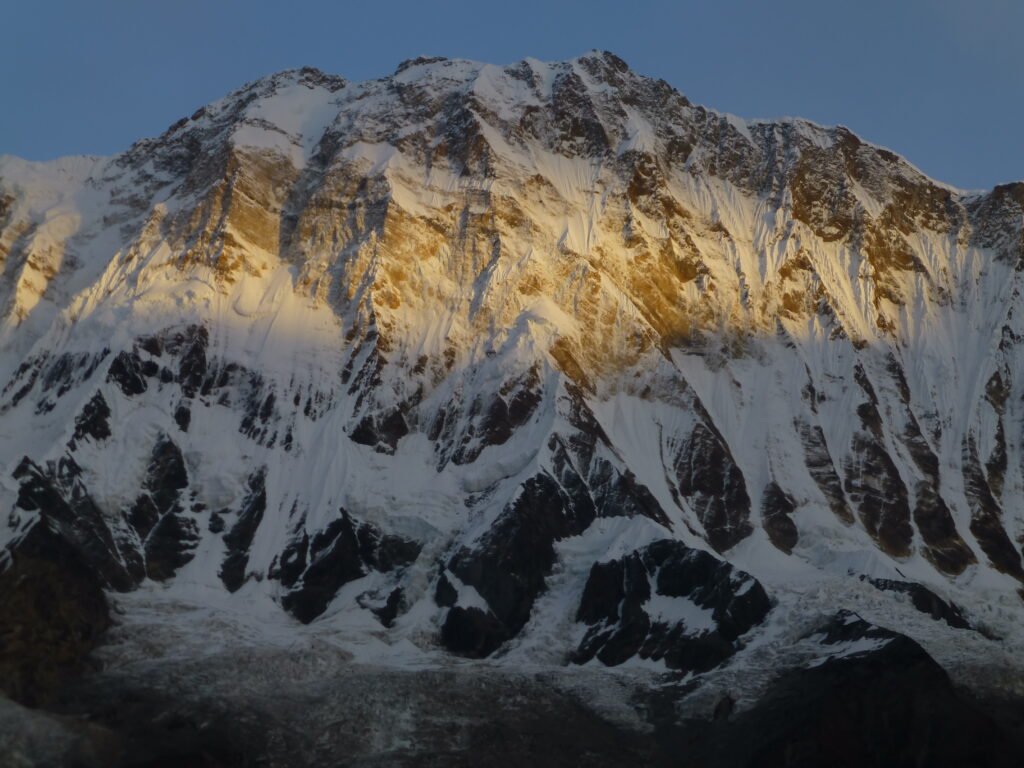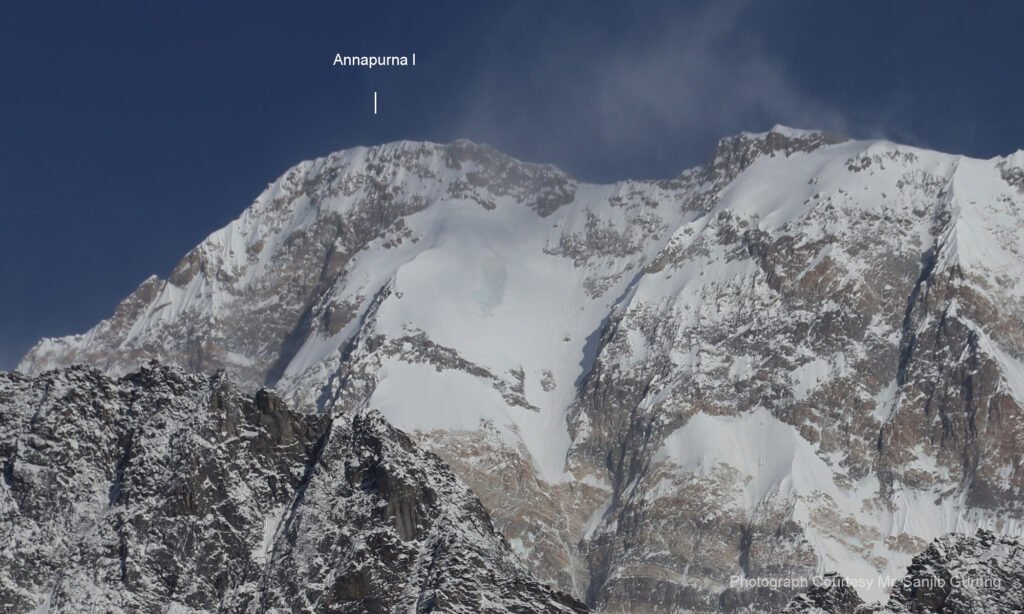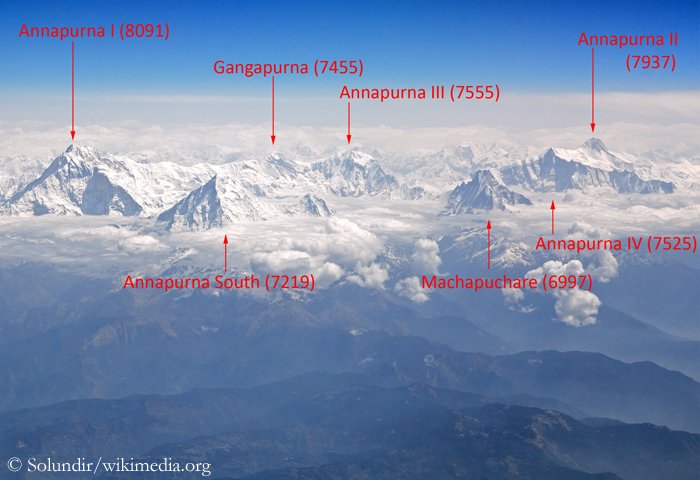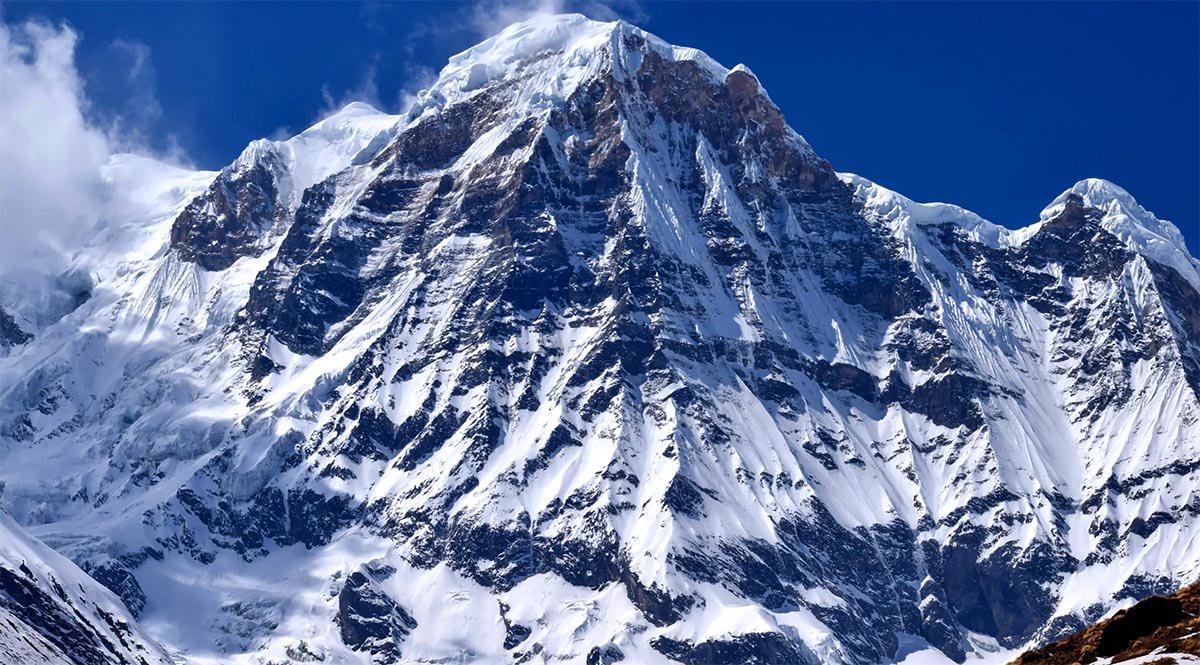Introduction
Annapurna I is the 10th highest peak in the world as it rises to an altitude of 8,091 meters (26,545 feet). Annapurna I, also known as A-1 or Main, the most feared and iconic mountain in Nepal. Though not the highest mountain in the world, it is among of one of the deadliest to climb. The mountain sits in the Himalayas of Nepal, and despite being just 23,389 feet (7,135 m) high — a mere dwarf compared to Everest’s 29,035 feet (8,850 m) or K2’s 28.251 feet (8,611 m) — it has ended more lives than those other behemoths combined. For mountaineers, Annapurna I is all risk, all challenge, and all deadly charm — the kind for which only expert and daring climbers would dare drop everything to spell.
Well, in this blog I shall pen down my observations through years of mountaineering and researching for content writing. Annapurna I is so much more than a mountain: it represents the staggering might of nature, and it fights back with as much power as any human being who dare think to challenge.
1. A Brief Introduction to the Annapurna I
Annapurna is a series of peaks in the Himalayas, a 55-km long massif of which the highest point, Annapurna I Main, stands at 8091m making it the tenth-highest summit in the world and one of the 14 “eight-thousanders”. The massif itself, however, includes Annapurna I as well as several other notable peaks: Annapurna II (7,937 metres), III (7,555 metres), IV (7,525 metres) and Gangapurna (7,455 metres).

Annapurna is the name of a female deity who symbolizes feminine power and is counted as being the goddess of that abundance and harvest. Understandably so, as the people from Nepal believe that the Annapurna Circuit is sacred and I can see why. The glacier-wrapped heights of the Annapurna massif are staggering, and you will see the nature that surrounds you conforming to a daunting beauty camouflaging malignant threats awaiting in the folds of its mountains.
The highest mountain in the massif is Annapurna I – the tenth highest and one of the deadliest mountains on Earth. Despite the attracting some of most daring climbers since its first ascent in 1950, technical demands, unstable weather conditions and regular avalanches have evolved it into something of a mountaineer’s graveyard. With one of the highest death-to-summit ratios among all 8,000-meter peaks and a reputation for technical difficulty, it is clear that its testing nature can be intimidating even to many seasoned alpinists.

2. Annapurna I – The Deadliest of Them All
Annapurna I is known as the deadliest mountain in the world to climb, especially amongst mountaineering circles. A closer look at the numbers and it will become clear why Annapurna I has earned itself this grim reputation.
While they soon vocally launched a fair share of negative publicity in their attempt to tell the story, history sided with Herzog — hundreds have since perished on Annapurna I (and down Annapurna South) just the same. Over decades the long-form death-to-summit ratio sat at 32%, meaning 1 in 3 climbers who made it to summit died trying.
This ratio has declined in recent years with better technology, more types of gear, and improved weather forecasting (as intense as it can be on an isolated peak like K2), but is still standing at a level hazardous to many other 8,000-meter peaks.
Why Is Annapurna I So Deadly What makes it have a bad reputation?
Unpredictable Climate: As with so many mountains over 8,000 meters in height, it is also victim to quick climatic fluctuations. Yet, its position on the planet and its topography makes it particularly prone to sudden storms, high winds and heavy snowfall. With the ever-changing extreme weather conditions, that can shift even in the span of hours, any attempt to reach the summit is a gamble.
Little or no warning of an avalanche b Several climbers consider avalanches as one of the most capricious threats on the mountain. Given the fact that ever since Annapurna I was first summited, many skilled mountaineers have lost their lives in avalanches just trying to reach the top summit.
Deceased and standing at 26,545 feet: a relatively small number among the league of 8,000m peaks this is actually ranks as one of the more technical. They are steep and exposed to the elements with hazards such as icefalls, crevasses and seracs.
The south face of this moutain has since been the scene of some especially treacherous climbs considered one of the most difficult and dangerous objectives in all of mountaineering. Getting through these sections demands expert climbing ability and ice cold calm.
Accessibility: This natural beauty is in a rather isolated region of the Himalayas. Although the Annapurna region is regularly visited by trekkers, climbing Dadu Chirin and then scaling to the top of Annapura I puts climbers far beyond any possibility of rescue.
Rescue operations, if at all possible for difficult terrain and harsh weather conditions that prevail in the last region of the land altitude. Climbers need to be entirely self-contained and prepared to face any conditions in which they may find themselves stranded.
3. Tracing the Mystery of The First Ascent
On June 3, 1950, Annapurna I was conquered by a French team led by Maurice Herzog and Louis Lachenal. The mountain became a significant peak in the history of climbing, as it was the first time an 8,000 meter summit had been climbed. The success of the expedition was achieved at a huge price: Herzog and Lachenal would both lose toes and fingers to frostbite.
Herzog’s description of the ascent, chronicled in his book “Annapurna,” remains one of the most enduring tales in mountaineering history, attracting climbers for generations to strive for its summit despite a death toll that has included an entire team. The tale of the first Ascent of Annapurna I is one of adversity, courage, and the success of man over even mightier tribulations.
However, it also paved the way for the threats that would later manifest themselves at Annapurna I — Herzog and Lachenal’s descent was very fraught, and both of them suffered severely from cold temperatures, fatigue and injuries. Their ordeal is a grim lesson in the hazards of climbing Annapurna 1 and the fine line between success and catastrophe.
4. The Routes of Annapurna I
The climb ofthis mountain has a few different routes on offer for climbers, each having danger and difficulty all their own. Routes that are most tried are:
It is the normal route travelled by climbers attempting Annapurna I and it is The North Face which is considered as one of the less technical routes but not called an easy one. Climbers are challenged with navigating ice slopes up to 85 degrees, crevasses, exposed ridges and the always-present hazard of avalanches. The North Face route does demand a good level of fitness and steep climbing skills, but it is the easiest of realistic options for climbers who have their mind in getting to the summit.

South Face: The south face of it is probably the most treacherous climb in the world Although successfully ascended in winter, Anna I South Face was never summited and may as well remain so forever. It is a very steep, technical mixed rock, ice and snow route ,which includes several ice fields, with overhanging seracs.
The South Face is very risky with a considerable danger of avalanches and rockfall, so it is a route that typically only experienced alpinists venture forth on. The beauty of the views that those who can successfully navigate the South Face, are some of the most spectacular in the whole of Himalayas. However, this is one of those dangerous and so scarcely attempted routes.
Alternative Routes: Throughout time, a range of other routes including the West Ridge, East Ridge and Northwest Face have been attempted by climbers on this dangerous mountain. It is less popular among climbers due to the routes being some of the more technically difficult and longer, along with it simply having more objective hazard than other parts of the mountain. Each route offers its very particular set of challenges, from rockfall to avalanches and ice-climbing,crevasse-hopping.
Climbing this mountain is a tough, dangerous and long route regardless of the trek climbers take, where an overall high level of preparation and some serious mountaineering experience are prerequisite to dealing with conditions that have stood in the way for many others.
5. Training For Annapurna I: How that Works
And finally, this majestic beauty is not everyone. It requires a level of physical fitness, technical skill and mental toughness most do not have. But before embarking on this intrepid journey, it is extremely important to consider several fundamental aspects of making the expedition to Annapurna I worthwhile.
1. Physical Fitness
It is among the 14 peaks around the world with an altitude exceeding 8,000 meters and as such, making it to the top of Annapurna I as well is no mean feat. Climbers are expected to have excellent fitness, cardiovascular ability and be able to carry heavy loads up steep technical terrain. Appropriate training is required for strength, power, and also stamina as the focus should be on climbing high altitude.
Most climbers take many months, sometimes years, to prepare for an expedition because they must slowly build up their strength and stamina via a routine of exercise, including aerobic training and regular practice climbs on smaller mountains. You’ll really struggle with every step you take above base camp; so even if this training feels a bit boring and monotonous, it’s essential for simply staying alive the mountain.
2. Technical Climbing Skills
Beyond being in top physical condition, climbers must also be highly-skilled technical climbers to navigate the technical terrain of Annapurna I; this means being a proficient ice climber, crevasse rescuer, glacier tramper, and user of traditional climbing gear such as ropes, crampons, ice axes etc. A knowledge of avalanche assessment, rope system management, and the technical rock and ice climbing skills is vital to a successful ascent.
Most climbers come to Annapurna I already having climbed some of the other high-altitude peaks, gaining their skills climbing in places like Denali or Aconcagua, or on another high Himalaya peak.
3. Acclimatization
Appropriate acclimatization is one of the key factors in successfully attempting an 8,000-meter peak, since it helps prevent altitude sickness (which can be deadly) by allowing climbers to become accustomed to the thin air at high altitudes. Mountaineers need several weeks of acclimatization to survive at these altitudes, where temperatures can reach 40 degrees below zero.
A classic expedition regimen made popular by climbers of the world’s highest mountains, acclimatizing at base camp and climbing higher each time until their bodies adjust to the decreased supply of oxygen.
Acclimatization requires a fine line between ascending to higher and returning to lower altitudes. Climber climbs Annapurna I with establishing higher camps during the expedition.
4. Mental Preparation
Climbing this moutain, is mental game more than a physical one. The bitter cold, isolation and perennial hazard can break the strongest of aficionados. The mental toughness and resilience required to persevere during those long days in the mountains is crucial, as you face the understandable dread of avalanches or simply the never-ending fatigue both physically and mentally that comes with climbing at high altitude.
Climbers also need to be ready for failure.It is known as the killer mountain for a reason; there are few things harder than turning back from a summit when your instinct is pushing you forward. Mental preparation encompasses risk awareness, the knowledge of when to bail and most importantly, an acknowledgment that the mountain will always be there to be climbed on a later date.
You can read this article for more information regarding mental preparation to for moutaineering.
6. The Base Camp & The Climbing Experience
The ascent of this starts at base camp, which is situated at an elevation of nearly 4,200 metres. There’s the trek to base camp, which is an adventure in its own right, snaking climbers through the stunning Annapurna Sanctuary, a natural amphitheater circled by monumental peaks. On the trail you weave through lush forests, terraced fields and traditional Nepali villages—giving you a taste of culture and life in the area.
After landing at the base camp, they stay there for several days to acclimate and prepare for the climb. Base camp is a hive of activity — tents sprawled across the glacier with climbers, guides and porters preparing themselves for the ascent. Teams are put in a state of mild apprehensive excitement, going through their final rituals and hoping for a weather window to get started up the mountain.
Climbers build successively higher camps on the mountain above base camp, moving closer to their objective of the summit. The route includes steep ice slopes, crevasses and seracs, with each camp situated higher on the mountain. The ascent is a brutal endurance test, with climbers spending weeks on the mountain at altitudes which have crushed lungs and boil blood, as well as battling frostbite, high winds and the ever-present threat of avalanches.

Into the All-Or-Nothing Summit Bid With each entry compiled in the words above, you may appreciate a turning point that can create either utter gratitude (or breathtaking heartbreak) on summit day.
The final stretch, leading to the summit of Annapurna I is a true mutants paradise. Camp 4 is the usual departure point for climbers, situated just below about 7,400 meters (24,278 feet). Here the summit pyramid is climbed directly, the mountain’s more technical and exposed parts — steep ice walls, knife-edge ridges and wide crevasses.
The air at this elevation is so thin and every step just seems like a lot of hard work. Climbers have to pace themselves carefully without overexerting and must also closely monitor weather conditions and avalanche danger. The summit push itself can last between 8 and 12 hours depending on the conditions, and climbers have to be able to down climb if the weather changes or the conditions worsen.
To summit is a great accomplishment but at high cost. The climber who has been more to the I of Annapurna have described in some place near the edge front approximates one’s own living organism as factory and image in a way from pioneer claustrophobic, heady that it is impossible taste enlargement descending.
7. ANNAPOURNA I Tragedies
By reputation one of the world’s most treacherous mountains, has killed many climbers since it was first climbed in 1950—one of them when he reached out for a bottle. The most famous is the tragic tale of Anatoli Boukreev, perhaps Russia’s greatest mountaineer until he was killed in an avalanche on Annapurna in 1997. It is a terrifying reminder of the worst-case scenario that can happen when even climbers with Boukreev’s incredible skill and experience from having summited Everest without supplemental oxygen push it too far on one of 8000ers — an unpredictable mountain like Annapurna.
Similarly was the sad tale of French climber Jean-Christophe Lafaille, who went missing as he made a solo winter bid on Annapurna I in 2006. None of that mattered in Lafaille’s case, however — and his disappearance remains one of the many Annapurna enigmas.
These stories are also a stark reminder of the risks inherent in climbing Annapurna I, one of the personalities that in itself is majestic mountain and very rough, but no less refined by this fact has been achieved perfection. The dangers of trying to climb Annapurna I are obvious, but the idea of reaching its peak still makes it one of the most sought-after expeditions.
Conclusion
Annapurna I is still considered one of the most extreme, and difficult mountain anywhere on earth but many climbers who aspire to push themselves to the very edge will continue to be drawn to it. For the daring few who are willing to take on Annapurna I, this can be a once in a lifetime opportunity with stunning views, harsh conditions and the reward of reaching one of the world’s most challenging summit.
Annapurna I’s legacy is of epic proportions, adventure, tragedy and triumph. The unique story of the climb and features surrounding each climber make Mount Everest even more interesting compared to other mountains climbers might summit. Ah, Annapurna I… The mountain that speaks not just of the classic mountaineering tale but of the human spirit itself and adventure at any cost!
Future mountaineers, however, must not become obsessed with gaining the summit. The journey, the struggle that is tackled head on, the people that surround you and the sense of awe toward standing in a gigantic shadow in front of one of the toughest mountains to summit around.




